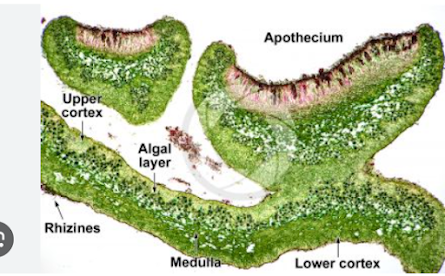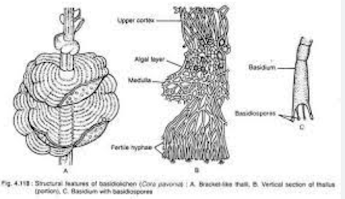Lichens: Structure and Function of Lichens
Lichens
The word Lichen derives from the Greek Leichen (tree moss, lichen, lichen - like eruption on skin". A lichen is not a single organism. They are found in a symbiotic, mutually beneficial relationship. The combination of an alga with a fungus creates lichen. The fungus is the main component of lichen. Lichens are composed of several organisms from three different kingdoms: fungi, plants, and bacteria. Lichens are not single organisms but an intimate symbiosis of fungi, most often an ascomycete, and a photosynthetic alga or cyanobacterial species. The association of these separate organisms is often referred to as a mutualistic relationship, defined as two or more organisms living in a mutually beneficial arrangement. Most often the symbiosis association includes a second photosynthetic partner (Photobiont) but only one fungus (mycobiont) per lichen. Spribille et al. have rewritten this dogma by identifying lichen involving two mycobionts and demonstrating that such trinogamy is very common.
The protective role of the fungus has allowed lichens to inhabit extreme environmental conditions and is one reason they can be found on every continent. Lichens can be found living on rock surfaces in harsh climates that would prove lethal to the photobionts on their own. Even more impressive, lichens have been observed performing photosynthesis while frozen at -20°C (-4°F).
The fungus absorbs water from the surroundings and makes food for the alga. The fungus offers protection and shelter for the alga. Cyanobacteria can also be called blue-green alga, despite their distinct nature from other algae.
The mosses and lichens are different. The mosses are actual plants, while lichens are the combination of fungi-algae. One can find lichens growing abundantly in many places, including rocks, walls and gravestones, roofs, trees’ barks, soil, and roofs. They are part of the group of terrestrial organisms.
Structure of Lichens:
Photobiont, which contains chlorophyll, is the non-fungal portion. There are many lichen partners. Some include only one photobiont, but this is not always true. Each filament is called a hypha, which is the fungal partner. These hyphae can branch, but keep a constant distance from each other and grow by extension. Some lichens are filamentous, and others have more or fewer cells.
The lichens share an identical internal structure due to the diversity in basic growth. The bulk of a lichen’s body is made up of filaments from its fungal partner. The relative density of these filaments determines the layers. To form a cortex, the filaments are tightly packed at their outer surfaces to help contact each other. The algal partner cells do not reside below the cortex as the fungal filaments are distributed. Below the algal layer is the medulla, which is a loosely woven layer of fungal filaments. Another layer is found beneath the medulla of foliose and crustose, and it is directly in contact with the substrate in squamulose or crustose.
The lichens do not have a waxy cuticle, as do plants. They also lack vascular tissue like xylem or phloem that moves nutrients and water around their bodies.
Basidiomycetes and Ascomycetes are the most commonly found lichen fungi. Common algal partners include either the green algae Chlorophyta or the Cyanophyceae blue-green bacteria family. Although fungal partners cannot live without their mycobionts, algae can live in water and moist soil. Although a large lichen can create a thallus that is up to 3ft in length, most lichens are only a few centimeters long. They come in a variety of colors, including yellow, green, and black.
Mostly, lichens grow slowly. One in which the phycobiont can be found is a blue-green bacteria that has the ability to convert nitrogen gas to ammonia. Some lichen can live for the age of several centuries, but they are more likely to be those who have lived in extreme environments like the alpine or arctic tundra.
Different types of lichens:
There are many other kinds of lichens. They are divided into various types based on their unique characteristics.
Based on their growth, the lichens are divided into the following categories:
- Crustose Lichens: Crustose and other lichens are thin, flat, and have no distinct lobes. They can be found attached to rocks, rocks, barks, trees, or the trunk of trees. Graphic scripta and Haematomma puniceum are two of the most well-known examples of crustose lichens
- Foliose Lichens: Foliose lichens are much more attractive than other types. They have a flat, broad, smooth, and leaf-like shape. It has a distinct upper and lower surface. This type of lichen is usually attached to rocks or twigs by the rhizoid. Several examples of foliose lichens include Cluiudhuria and Parmelia, as well as Xanthoria and Cetraria
- Fruticose Lichens: These are the most important types, as they are small and easily branched. Fruticose and other lichens are larger, more attractive growths that stand out from the branches of trees and foliage. Common examples of fruticose, lichens include Usnea, Ramalina and Cladonia
Based on their habitat, the lichens are divided into the following categories:
- Lignicolous: These lichens are found in the woods
- Corticolous: These lichens live on bark from trees
- Saxicolous: These lichens can live on rocks or stones
- Marine: These lichens can be found near the coasts of the ocean on siliceous rocks
- Freshwater: These lichens can be found on hard siliceous rocks near freshwater
- Terricolous: These lichens can be found on the soil and are also known as terrestrial lichens
Based on their internal structure, the lichens are divided into the following categories:
- Heteromerous lichens: The algal component of the thallus is not distributed but is limited to a specific area in heteromerous lichens. It also has a layered structure that is well-differentiated
- Homoiomerous lichens: The algal component is distributed uniformly among the fungal components in the homoiomerous lichen. The thallus has a simple composition and is not differentiated
Based on their fungal companion, the lichens are divided into the following categories:
- Ascolichens: These lichens contain a fungal component that belongs to Ascomycetes
- Basidiolichens: Basidiomycetes are responsible for the fungal component of these lichens
- Hymenolichens: These lichens contain fungal elements that belong to hymenomycetes.
Uses of lichens:
- Air quality engineers use lichens to help determine air quality. The lichens are sensitive to and can be affected by certain pollutants, such as heavy metals, sulfur dioxide, fluorides, radioactive fallout, and heavy metals. They can also be used as bio-indicators to monitor air quality and pollutant levels by watching their behaviour
- Lichens have been employed in producing colors, fragrances, and traditional remedies for centuries
















Comments
Post a Comment